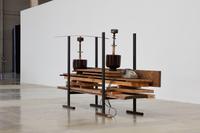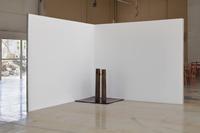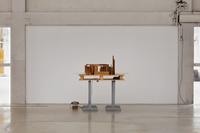Micol Assaël: Converting Words
Four sculptures-assemblages testify to the artist’s fascination with natural and physical phenomena. Vibrations and energies inexhaustible by human perception can be perceived behind their factual, silent presence.
I first met Micol Assaël almost twenty years ago in Rome; she had a studio in the same building as Jorge Peris, with whom I was preparing an exhibition. His admiration for the silent and thoughtful Micol was unfeigned, and a little incomprehensible to me at the time. However, I found it all much clearer a few years later at the Kunsthalle Basel, where she had her exhibition Chizhevsky Lessons (2007), prepared in collaboration with curator Adam Szymczyk, then director of the Kunsthalle.
The main role in the uncompromising, difficult to produce, but above all extremely impressive project was played by high voltage, the electromagnetic field and the viewer as a medium of its presence. The central, eponymous work of the exhibition referred to scientist Alexander Leonidovich Chizhevsky, whose fate is a pure example of the dialectic of the “positively discriminated and rejected,” characteristic of the careers of prominent personalities working in Soviet Russia under Stalin.1 The project itself consists of installing twenty copper plates in an empty room filled with static electricity. The artist worked on it in collaboration with Mikhail Pavlovich Kokurkin from the High Voltage Research Institute at the Institute of Electrical Engineering in Moscow during her long-term scholarship in Russia. The work uses “a transformer, a generator and a system of wires that transform air particles into negatively charged ions generating a static charge in space, so that the whole room becomes a giant capacitor, exposing visitors to small electric shocks when they touch each other or another object.”2 The room is therefore also filled with a barely-audible crackling sound. The subtle but extreme experience, when you get lost in perceptions activating space recognition on an unusual level, brings on a special kind of “bodily illumination.”
Working with the electromagnetic field, discharges, electricity and various devices that produce, distribute, accumulate and transform it is a kind of tell-tale characteristic of Micol Assaël. The leitmotif of a series of installations presented together in 2014 at a large exhibition in the prestigious HangarBicocca Gallery in Milan, founded by the Pirelli Foundation, was a principle of containers or semi/closed space elements/structures that transformed the exhibition venue into a place reminiscent of an engine room or a kind of technical workplace. With this unifying gesture of selection from her previous work, the artist articulated her variegated interests related primarily to energy electromechanics, but also elements and sounds that thematise, no less than discursive practices, the possibility or impossibility of controlling the uncontrollable, the irrational element in science and technology, the emotional charge of the non-human, or the functionality of what has been non-functional. Yet, the strong structural aspect of the exhibition layout and the seemingly withdrawn, cold, non-artistic nature of the whole as well as of individual works deceive. As soon as the viewers approach or enter them, they are seized by an affect, each time slightly different in modulation, arising from the physical and at the same time intellectual engagement that the works require of them.
A slightly different line of Micol Assaël’s work is represented by works related to natural phenomena and environments, which are based on metonymy, or more or less mediated record. The sculpture-objects Eldfell (2006), Karymsky and Malii Semiacik (the two from 2009) made of copper filings supplemented with a sodium lamp, and in some cases also microscopic glass particles, refer to the volcanoes with the same names (the former in Iceland, the latter two in Kamchatka). My favourite video Overstrain (2012), very simply shot but hallucinatory, captures the view of an arid landscape through the dirty windscreen of a moving truck, with flying bees unexpectedly appearing around it from both sides. The loud buzzing of the bees is played by a multi-channel audio system, which can be confusing and disorienting for the viewers, irritate them, or, on the contrary, leave them completely indifferent.3 On the other hand, the installation Inner Disorder from 1999–2002, created after the artist’s return from Iceland where she stayed for more than a month, is very personal. The delicate, biomorphic records from the borderline of waking and dreaming drawn in white ink and always enclosed in a circle highlighted in pencil, are installed by the artist in a slightly different way each time, according to the context of the presentation. The drawings can be perceived as a visual language of waking dreams and indistinct visions, syntactically relatively sober, but semantically very rich, as a kind of boundary, a subtle and muted experience of the Nordic landscape.
Since the beginning of my activities in Ostrava, an exhibition by Micol Assaël has been on my wish list; we were only waiting for the right moment and context. In the meantime, the artist was able to pay us a visit when she attended a conference dedicated to internationally acclaimed Romance scholar, philologist and linguist Jaroslav Šabršula (which testifies to the breadth and very specific focus of her interests), organized in 2018 by the University of Ostrava. For the exhibition at PLATO within our year-round project Oh and Hah, Beauty, Ruin and Slack, the artist and I have finally chosen works of expressly sculptural nature that she has been making during the past few years and that develop the principle of assemblage, long present in her technically and physiologically activating works, and spatial imagination, sometimes slightly overshadowed by the affect evoked in the viewer. Thematically, though, they deal again with the research into natural or physical phenomena and forces, and with the interactions of common materials and used, found things that have been discarded, with the environment and human perception, silently referring to their original function. The individual sculptures and their constellation in space are activated by the view and cognitive capacity of the moving viewer, for whom they should ideally oscillate between their presence as something that simply appears, and the incentive for a kind of phenomenological exploration. Through their titles, these works are involved in a language game that, in my opinion, is not merely a system of designating and communication, but is, rather, present as a fact that somehow objectively persists even without anyone looking at them.
The artist named three of her recent sculptures with Japanese characters, emphasizing the “materiality” of names in our civilizational context, while the fourth and earliest one refers through its name to an enigmatic short story by Herman Melville, Bartleby, the Scrivener (1853). The English meanings of the Japanese titles of the three statues (温 On, 意 ⾒ 見見 Iken, 学名 Kumanbachi) are “warmth”, “opinion” and “bee”, respectively. They seem to provide a simple guideline assigning meaning to what we are looking at. For example, 温 On from 2018 can be interpreted, in a simplified way, as a model of a city (Rome?) in ruins. As if the city had been hit by a climate catastrophe connected to a prehistoric telephone with which no connection can be established with anyone. The sculpture-model represents a process or state in which we as people take part, but which ultimately includes us not as subjects, but as objects of its action. As individuals, we can think of it only through the capacity we have, in this case, through physically experiencing the space, seeing, observation, affects, and contemplation. But this brings us back to the question of why these three works are named in Japanese. My speculative answer is that in the intentions of the title of the Converting Words exhibition, taken from last year’s presentation at the Sprovieri Gallery in London, which contained a fourth work with the Japanese designation 日光 Nikkō (sunlight),4 these are not titles of individual works, but primarily a transposition of Japanese words and characters, their transformation or exchange for a material aggregate of meaning. This is a matter of an endless process of “conversion” from the naming into a thing and vice versa, a paradoxical attempt to establish a cycled state–process through the relationship between a word and a thing.
The fourth and earliest exhibited sculpture by Micol Assaël is from 2013; it is titled Preferirei di no (in English “I would prefer not to”), i.e. one of the most famous – and in recent decades also most commented by philosophers – sentences in world literature. Composed of found beams, used wooden beehives, a ceramic insulator and sand, it launches a seemingly literal play of meaning with motifs of extinguished effort, non-functionality, elapsed time and insignificance. Rather than through these anthropocentric-like references, though, I prefer to perceive the work Preferirei di no in its phenomenal givenness from which one can derive the interpretation of “Bartleby’s formula” in the sense of radically simple and nowhere-leading absence (of functions and meanings). Rather than taking into account Žižekian, Agambenian and Deleuzeian attempts to use the unexplained (and inexplicable) rejection of the protagonist of Melville’s short story, Bartleby the scrivener, the refusal to engage and participate in social rules and human communication as a model or utopian imperative of radical political behaviour, or better a symbol of a specific resistance to power, a resistance based on passivity, I find it more appropriate to approach Micol Assaël’s sculpture from an ontological perspective. For me, this work of art indeed embodies “Bartleby’s formula” in reference to the inaccessible unconditionality of our world’s affiliation with what this world, constructed by ourselves, does not contain and in which we ourselves are contained.
To succumb to the usual temptation and claim that Micol Assaël‘s work deals with phenomena transcending us would be to throw away the opportunity to dispel the romantic mist obscuring any attempt to convey a fact that is fundamentally independent of the subject. With regard to the shift of perspective that has occurred in the past two decades, it seems productive in the case of Micol Assaël to talk about a certain kind of philosophical realism, when the artwork takes as its theme the disintegration of the notion of the world in the form that we still handle in ordinary discourse. Among other things, the artist is concerned with the controlled destruction of a certain conceptual construct related to a conceivable whole established and oriented according to the subject, a whole that is centred, since the beginnings of the modern era, around Descartes’ cogito like the eye of a hurricane.
However, fundamental experience and facts with which we have been increasingly confronted and which escape the consolation of the subject–object matrix of the waking dream of everyday life, defy such a model or conception of the world, which is the result of the Western tradition of thought and practice of “self-realization” (based, among other things, on the domination of humans over nature). Here I refer to the concept of hyper-objects in the sense encountered in Timothy Morton. The climate and environmental crisis, but also the increasingly apparent helplessness of a paralyzed entity that is absorbed and transformed by the expanding virtual universe or the elusive forces of global capitalism, are common denominations for what we experience through a very specific occurrence, the correlate of which actually eludes us. We can no longer make do with a romantic idea of the noble that arouses horror by transcending us utterly. We can think and process the noble. It can be related to the immediate human experience. The hyper-object remains in the shadow of phenomena difficult to conceptualize.
Accepting the real existence of those “things per se” that, however, cannot be managed in the Kantian spirit by criticism of pure reason, somehow brings a kind of relief: if not everything depends on us as individuals and on humanity as a cosmic marginality, then we can fully dedicate ourselves to the responsibility for that which we can influence here and now, we can improve our relationships to the other by learning to accept it as an equal partner. Taking care of oneself deprived of an anthropocentric perspective opens us to other horizons. Affirmation and acceptance of being the objects of other forces and other modes of being can weaken the destructive potential of our presence on the planet and of subjective demands, and strengthen the respect for what we commonly classify as purpose, usefulness, and threat. Trying to turn the direction of our reflection and learn to think of the subject (and humanity as a whole understood as a subject) also as an object among other objects does not mean a return to control strategy that led to reality unexpectedly striking back, but to multiple tactics of “negotiating” with it. It may be that I am somehow pushing these motives and intentions into the work of Micol Assaël, but any radical or serious work of art brings enough preconditions for doing so.
Marek Pokorný
-
Alexander Leonidovich Chizhevsky (1897–1964) was a biophysicist and worked at the frontier of different scientific disciplines. The beginnings of research into the influence of solar and cosmic radiation on living organisms, solar cycles, eruptions on the Sun and geomagnetic storms are connected with his name. He paid special attention to the effects of ionized air on animals. He put into practice aero-ion therapy, the forerunner of today’s therapy with negatively ionized air, in some medical facilities. His theory of the influence of solar cycles on human history, which was his reaction to the correlation between historically remarkable activities and solar activity, marked the history of Russian cosmism. Chizhevsky also wrote poems and painted. ↩
-
See Micol Assaël: ILIOKATAKINIOMUMASTILOPSARODIMAKOPIOTITA, Milan, 2015, pp. 285 and 286. ↩
-
See Micol Assaël: ILIOKATAKINIOMUMASTILOPSARODIMAKOPIOTITA, Milan, 2015, pp. 342 and 343. ↩
-
Although the work from 2020 concisely shows the basic motives I deal with in the text, we did not include it in the Ostrava exhibition, because the light conditions and the nature of the exhibition venue would not, in our opinion, fit its subtle execution. It is in fact a glass plate with the inscription “reality is not contemporary” inscribed on it in the dust. These words, covered and highlighted at the same time by gradually accumulating dust, are projected on the wall in sunlight falling at the correct angle. ↩
Micol Assaël is an Italian artist, currently living and working in Greece and Italy. She investigates the characteristics of matter, physical phenomena and forces, and their interaction with humans and their experience. Micol Assaël has always combined her foundations in philosophical studies with a fascination with natural phenomena, technological theories and machines (she uses electricity, sound and organic materials such as wood and water to evoke unexpected dangers and the non-humanity of nature). Her work affects the cognitive capacity and senses of the viewer, creating unpredictable and uncomfortable situations that include physical and psychological reactions. Micol Assaël has had solo exhibitions at Pirelli HangarBicocca in Milan (2014); Secession, Vienna; Fridericianum, Kassel and the Palais de Tokyo in Paris (2009), as well as in the Galleria Nazionale d’Arte Moderna in Rome (2008) and the Kunsthalle in Basel (2007). The work of Micol Assaël was represented at group exhibitions of the Pinchuk Art Prize in Kiev (2012), at the Fondazione Sandretto Re Rebaudengo in Turin and at the Museum of Contemporary Art in Chicago (2009). Her work has been exhibited at the Biennales in Sydney and São Paolo (2008), the Berlin Biennale (2006), the Moscow Biennale (2005), the Manifesta (2004) and the Venice Biennale (2003 and 2005).
←→
Special thanks to the Ministry of Culture of the Czech Republic and Moravian-Silesian Region.




